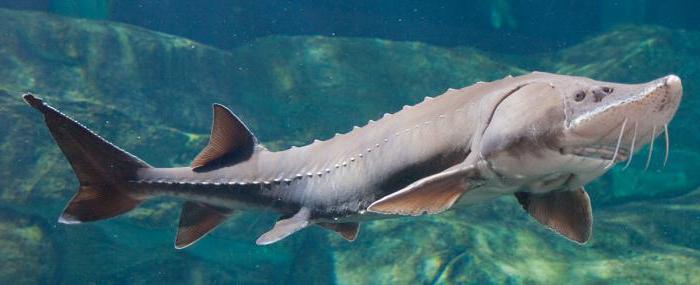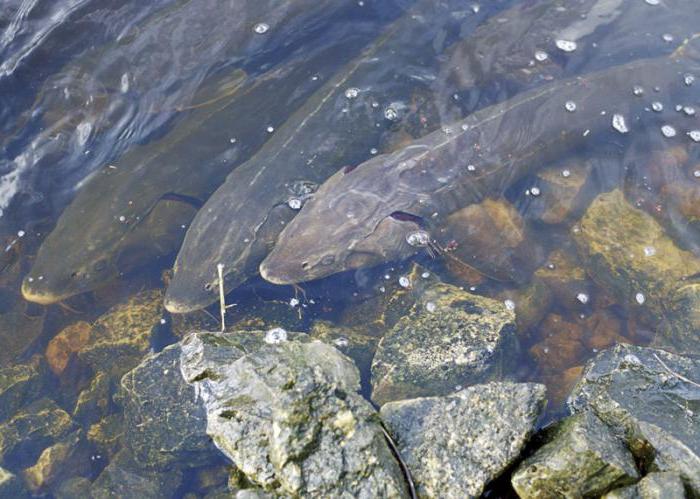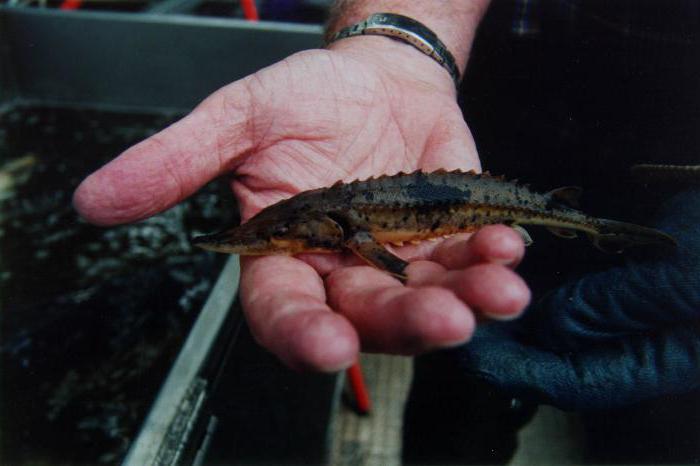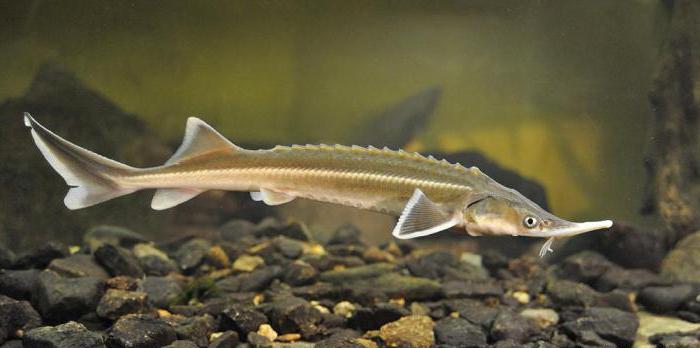“Red fish” - this term was the first to name exactly sturgeon fish. It is not a matter of the color of their meat, as we are accustomed to regarding salmon, but of a unique value, food and industrial. Unfortunately, such a valuable fish is currently on the verge of extinction.
The sturgeon family includes a few representatives that live both in Russia and abroad.
Origin history
This is a very ancient species of fauna. According to scientists, sturgeons appeared already in the Cretaceous period. In other words, they existed together with dinosaurs. Representatives of the species survived a major disaster in which a large number of representatives of the animal and plant world did not survive.
Until now, scientists have been studying that period of time by surviving sturgeon, more by their subspecies: spade-like.
Features
Fishes belonging to the sturgeon family have a peculiar structure that distinguishes them from all other representatives of the class. The main thing that is distinguished at the same time is a distinct chord, rigid cartilage. It is she who is the basis of the skeleton, which, by the way, does not have vertebrae, but only cartilage. Moreover, the skull consists of the latter. 
Another distinguishing feature is ganoid scales. It forms a kind of shell, consisting of ossified scutes. At the top, it contains a dentin-like substance - ganoin, and fish, respectively, are called ganoids.
The enumerated features of sturgeon fish will be incomplete if you do not mention the splatter - the hole located on the upper gill cover. By a special channel it is connected directly to the gills. Sharks also have shark-like.
All types of sturgeon are similar in shape to the body - spindle-shaped. The difference lies in the snout: for some it is pointed, for others - the xiphoid. At the bottom of the head is a mouth in front of which there are four whiskers - another feature of this species of fish.
Habitat
Sturgeons are mainly migratory, which means that they live in the sea, but spawn in rivers. Moreover, they prefer cool waters of northern and middle latitudes: their dense genoid scales are able to withstand low temperatures. The name of the sturgeon, leading a passing lifestyle: two species of sturgeon, Russian and Atlantic, beluga, stellate sturgeon, spike. Only the sterlet does not go to spawn in the sea, leads a settled life in clean rivers with a fairly strong current. 
The distribution area is the seas of the northern hemisphere and the rivers flowing into them. These are, first of all, the Black and Caspian, White and Azov Seas. Most often listed above sturgeon species can be found in Siberian rivers: Ob, Lena, Yenisei. It should immediately be said that this species is on the verge of extinction.
They lead mainly a benthic lifestyle, eating small fish, invertebrates (mollusks or worms), and are not disdained by insects. Beluga sturgeon is the only predator that feeds not on bottom organisms, but exclusively on fish.
There is another interesting regularity in the diet of this type of fish: they distribute the forage base of the reservoir among themselves: for example, the Russian sturgeon prefers mollusks, stellate sturgeon - worms and various crustaceans, sterlet - invertebrates.
Breeding
For the most part, sturgeon go to rivers to spawn. They choose those where the bottom is not muddy, but pebble. Also, factors such as clean water and a fairly fast flow are very important to them.
Sturgeon is not laid every year.This is primarily due to the fact that puberty comes quite late, because these fish are long-livers. The exception is sterlet, it breeds annually, as it leads a sedentary lifestyle.
Sturgeon spawning occurs in the spring and summer. Caviar is well attached to the pebble bottom, as it has a dense adhesive structure. Hatched fry have a special yolk sac, which is the first time their food source.  After some time, the bag resolves, and the sturgeon cubs begin to feed on protozoa (zooplankton), and even later, having matured, and crustaceans. Exception - fry of predators, beluga. They do not have a yolk sac; food is immediately independent.
After some time, the bag resolves, and the sturgeon cubs begin to feed on protozoa (zooplankton), and even later, having matured, and crustaceans. Exception - fry of predators, beluga. They do not have a yolk sac; food is immediately independent.
The grown up small fishes that summer begin to move to the sea. However, if spawning takes place in reservoirs, there are frequent cases of delays in young animals up to two years.
Fishing value
Sturgeon fish are especially valuable in gastronomic terms. From ancient times in Russia they were eaten, and not only meat was appreciated, but also caviar of a specific black color.
Nutritionists argue that the meat of these fish may well replace the meat of mammals, but it is much more beneficial due to the high content of vitamins and omega-3 acid - a particularly useful substance. The only limitation is high fat content: up to 20 percent. In any case, the meat of this group of fish is a great delicacy. Its use reduces the risk of oncology, hypertension and even depression.
Sturgeon fish and its relatives can be eaten in any form except salted. The fact is that in the meat prepared in this way toxic substances are formed, due to which severe poisoning can be obtained.
One cannot but mention the great value of black caviar. This is a kind of unspoken symbol of Russia. From ancient times, this product adorned holiday tables. It is many times more caloric and fatter than meat, in addition to a large number of vitamins it contains “light” proteins, minerals, and special nutrients. However, its constant use in food can lead to urolithiasis.
The gastronomic value of caviar depends on the color. The best is the royal, one that is extracted from fish, whose age exceeds 60 years. Her color is amber.
Security
Due to their high gastronomic value, sturgeon fishes were mercilessly hunted and killed for a very long time. Due to the long period of puberty and adulthood, they did not have time to reproduce offspring. Accordingly, the number was catastrophically reduced. At the moment, fish of the Sturgeon family (their photos are presented in the article) are listed not only in the Russian Red Book, but also in the international.
In addition, the limiting factors are the pollution of water bodies (recall, sturgeons live and spawn in exceptionally clean water), the destruction of breeding sites by industrial enterprises, and the construction of reservoirs.
An important role in the change in numbers is played by poaching. Officially, catch of all types of sturgeon is prohibited and punishable by law, but some citizens continue it, especially during spawning. Currently, there is a discussion about banning the fishing of this species of fish in general (until now, fishing is allowed for subsequent reproduction).
Sturgeon fish, whose price on the shelves is quite high, are sold only in small quantities. In industrial processing are individuals that are not capable of reproduction.
At the moment, breeding of sturgeon fish in special reserves is widely developed and their further release into the natural environment.
Sterlet
We will analyze each representative of sturgeon fish. Sterlet is the smallest of all, leading a sedentary lifestyle. It reaches 1.5 meters in size and weighs up to 7 kg. But such sterlet parameters are rare. The average value ranges from 2.5 kg of weight and length of 50-70 cm. The sterlet lives up to 35 years. 
The ability to reproduce comes late: at the age of five.Hence the main limiting factor: catch occurs before the fish brings offspring.
As for appearance, here sterlet is distinguished by quite often located bugs - special bone outgrowths on the body. There are no scales, it will be replaced by shields. The fish have a pointed nose, long enough. Below him are four antennae, almost reaching the mouth.
Abdomen yellow, back taupe. The bugs are bright, standing out against the main background. The fins are gray. This is the classic color of the sterlet, however, there are exceptions depending on the habitat.
Fish inhabit the river basins of the Caspian, Azov and Black Seas. Prefers Siberian rivers: Ob, Yenisei, Lena. At the moment, individuals grown in reserves have been released to Amur and Oka, as well as the Western Dvina and Neman. It is too early to talk about whether the sterlet will take root there or not.
Sturgeon
Sturgeon fish is perhaps the most common of all representatives of its species. At the moment, several types are distinguished, characterized by habitats. So, the Lensky and Amursky, as well as the white, Baikal and Atlantic sturgeon are known. Moreover, the latter has a very extensive habitat, which even extends to the borders of North America. All of these species are either migratory or settled. One thing brings them together: they all spawn exclusively in fresh water. 
The sturgeon differs from other representatives of the species (its photo is given in the review) in gray, which gradually turns into a lighter, even white towards the belly. The back is green-yellow. Unlike those of a sterlet, the sturgeon antennae are located at a sufficient distance from the mouth, they are rather closer to the edge of the snout. The individuals are very large. So, in 2014, almost a seven hundred kilogram sturgeon was caught. However, individuals rarely reach such indicators - their average parameters are 2 meters long and weigh up to 30 kg. Often there are hundred-kilogram fish. Outwardly, sturgeon is very similar to sterlet, only larger. The most widely known species are Russian and Atlantic.
Russian sturgeon lives in the basins of the Black Sea, as well as the Azov and Caspian. As a rule, spawning in the Volga other rivers associated with it. In the past, there have been cases of catching spawning fish, even in the Moscow River.
Adult individuals live at a depth of up to 100 meters, while young animals are content with a five-meter depth.
One of the main limiting factors is the construction of the Volgograd hydroelectric station, which violated the habitat and habitual habitat of the sturgeon. It simply became impossible for fish to return from spawning back to the Caspian Sea.
As for the Atlantic sturgeon, this is by far the largest representative of the species. These are long-lived fish, surviving up to a hundred years. There have been cases of catching Atlantic sturgeons up to 800 kilograms. The length is also impressive: some individuals reach six meters. Habitat - Baltic and North Sea.
Beluga
Beluga in appearance is slightly different from sterlet and sturgeon. It's all about a massive fat body and a dull snout. For good reason, its Latin name translates as "pig." It reaches a very impressive size. In fisheries, cases of catching of belugas weighing more than 1000 kg were known. At the moment, the average weight ranges from 200 to 300 kilograms. In addition, these fish are also long-livers: the age of some specimens exceeds 100 years. However, the average life expectancy is 45-50 years. 
In addition to the massive body, the beluga and a truly large mouth, which is necessary for fish to get food, are distinguished. The lips have a width comparable to the width of the head. The same large and antennae: they easily reach the mouth.
May have winter and spring forms. It depends on where the fish spawns and lives. Since young growth prefers to eat crustaceans, it keeps closer to their places of accumulation - estuaries. There, the shells are not so hard and quite small.
Beluga is a predatory fish. It feeds on bream, roach and carp. He does not disdain his fry, even relatives in appearance - other sturgeons.
Beluga very late begins to reproduce offspring: females - at 18 years old, males - at 14-15. The main river for spawning is the Don. However, the construction of dams that regulate river spills has a huge impact on the decline in numbers.
Stellate sturgeon
Stellate sturgeon fish is strikingly different from other sturgeons. It can be recognized by the characteristic elongated snout, which makes up to 60% of the fish head. Actually the whole body of the fish is stretched into a string. In addition to bugs, on the body of stellate sturgeon there are plates that resemble stars in shape. As for the characteristic antennae, they are very short, they do not reach the mouth at all. The lower lip is poorly developed. 
The color of the fish is quite dark: from a black-brown back it smoothly passes into a light, almost white belly.
Stellate sturgeon does not reach large sizes, like sturgeon or beluga. According to these parameters, it is similar to sterlet. The average length is from 1.3 to 1.5 meters, weight - from 7 to 15 kilograms. The fish lives long enough, up to 35-40 years.
In nutrition, the fish is unpretentious: it eats both small crustaceans, mollusks, and gobies, sprats and other small fish.
Stellate sturgeon lives in the Black and Azov Seas; in the Caspian Sea, it prefers the northern part. You can also meet her in the Sea of Marmara, and isolated specimens are found in the Adriatic. To spawn, like all sturgeons, it goes to fresh water: the Don, Kuban, Dniester, Bug, Danube and others.
Limiting factors include the construction of dams on rivers where fish reproduces, pollution of water bodies, and destruction of spawning sites.
Bester
Interspecific crossbreeding often occurs among sturgeons. It occurs both in the natural environment and on an industrial scale. To date, one of the most promising is a hybrid of beluga and sterlet. It is called a bester. This fish has incorporated the best qualities of the original individuals: high life expectancy, adaptability to fresh water, predatory type of food (from beluga). From the sterlet, the hybrid received the best gastronomic qualities and the early onset of the reproduction period.
The first individuals were bred in 1952. And after a few years, adult fish were released into the Sea of Azov, as well as the Proletarian reservoir.
As for hybrids in the natural environment, they are quite common, so it is almost impossible to track them. This is due to the fact that the number of sturgeons is too low.








